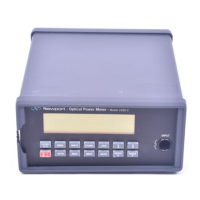51
The Service Request Enable Register is used to define the conditions of the
Status Byte Register that will generate an IEEE 488.1 service request,
<SRQ>. This register performs a bit-wise AND’ing operation with the Status
Byte Register. When an event occurs that causes a bit to be set high in the
Status Byte Register and its corresponding bit is set high in the Service
Request Enable Register, an <SRQ> will be generated once for the given
event. When the <SRQ> is asserted and a serial poll of the 1830-C is per-
formed, bit 6 and the bit(s) that initiated the <SRQ> will be set high in the
byte returned by the serial poll. A serial poll will clear the <SRQ> until it is
again asserted by a new event in the Status Byte Register.
NOTE
When using RS-232C, the service request <SRQ> and the serial poll fea-
tures are not available. However the state of the status byte register can
be obtained by the query, Q?.
Below is a description of each bit of the Status Byte Register.
PARAMETER ERROR:
This bit goes high whenever a valid command is issued but the command’s
parameters are out of range. e.g. U9
This bit is cleared by Q? or by the C command.
COMMAND ERROR:
This bit goes high whenever a bad command is sent regardless of the
parameters. e.g. H1
When the meter is in the HOLD mode, good commands which try to change
the measurement parameters will set this bit high.
This bit is cleared after an Q? or by the C command.
SATURATION:
This bit goes high whenever the photodetector is saturated, i.e. further
increase in the input signal level does not cause any change in the
measurement readings.
This bit goes low when the input signal is below the photodetector’s
saturation level.
OVER-RANGE:
This bit goes high whenever the input signal exceeds the maximum signal
level for the present signal range.
This bit goes low when the signal level is within range.
MESSAGE AVAILABLE, (MAV):
This bit goes high when any message is ready to be transmitted over the
interface. This bit is set only when the 1830-C is ready to respond with data
for an issued query.
This bit goes low after the 1830-C completes sending the message.

